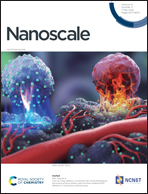Cocrystallization tailoring radiative decay pathways for thermally activated delayed fluorescence and room-temperature phosphorescence emission†
Abstract
Modulation of excited-state processes in binary organic cocrystals has been rarely explored so far. Here, we develop two charge-transfer (CT) cocrystal microrods with a 1 : 1 stoichiometric ratio where halogenated dibenzothiophene (DBT) compounds act as π-electron donors and 1,2,4,5-tetracyanobenzene (TCNB) acts as an acceptor. Unexpectedly, the cocrystal containing one bromine (Br) atom at the 3-position of DBT (3-BrTC) presents thermally activated delayed fluorescence (TADF), while the other one comprising one Br atom at the 4-position of DBT (4-BrTC) exhibits both TADF and room-temperature phosphorescence (RTP). Experimental and theoretical calculation results reveal that CT interactions in 3- and 4-BrTC decrease the S1–T2 energy gap, whereas abundant lone-pair electrons from the Br atom in 4-BrTC facilitate the n → π* transition. As a consequence, single TADF and dual-emissive TADF/RTP were realized, respectively. The present work offers wonderful insight into the effect of molecular structures on the excited-state pathways of organic CT cocrystals.



 Please wait while we load your content...
Please wait while we load your content...